Analyzing the Influence of HR Best Practices on Satisfaction
VerifiedAdded on 2022/09/28
|10
|2202
|43
Report
AI Summary
This report investigates the significant role of Human Resource (HR) best practices in influencing employee satisfaction within organizations. The research explores the impact of HR strategies on employee motivation, empowerment, and overall job contentment. The study includes a comprehensive literature review, examining how transparency in process design, effective communication, reward and recognition programs, and training and development initiatives contribute to employee satisfaction. The methodology employs a positivism philosophy and a deductive approach, utilizing an explanatory research design. Data collection involves a mixed-methods approach, combining a survey distributed to 50 employees and interviews with 3 HR personnel. The report aims to identify the need for HR best practices, examine their influence on employee empowerment and motivation, understand the correlation between these practices and employee satisfaction, and suggest recommended activities for improvement. The findings are structured around research objectives and questions, with a hypothesis testing the impact of HR best practices on employee satisfaction. The report concludes with a detailed timeframe for the research process and a comprehensive list of references.
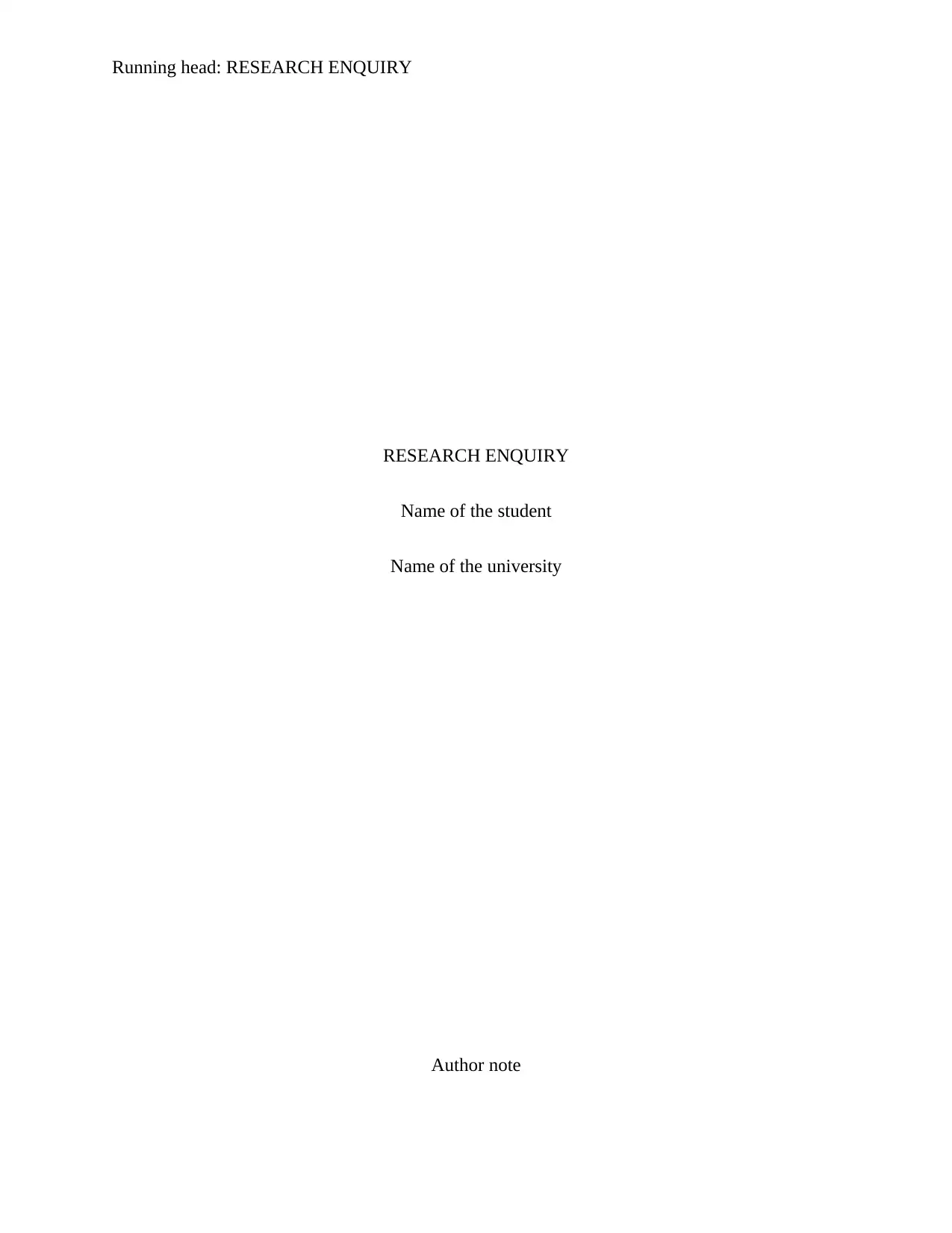
Running head: RESEARCH ENQUIRY
RESEARCH ENQUIRY
Name of the student
Name of the university
Author note
RESEARCH ENQUIRY
Name of the student
Name of the university
Author note
Paraphrase This Document
Need a fresh take? Get an instant paraphrase of this document with our AI Paraphraser

1RESEARCH ENQUIRY
Topic: The key role of HR best practices in influencing employee satisfaction
1.Introduction
1.1Background
HR best practices enable an organization in influencing the rate of employee satisfaction
through motivation and empowerment. Aguenza and Som (2018) stated that the transparency in
the process design and ease of communication enables an organizational HR in developing trust
and confidence among the employees. Efficient communication between the employees and the
managers enables an organization in identifying the issues and mitigating the same. On the other
hand, the aspects of employee satisfaction are greatly dependent on the reward and recognition
programs that are initiated by the HR personnel of an organization.
Zhong, Wayne and Liden (2016) opined that the HR personnel of an organization
develops effective reward and recognition programs with the objective of encouraging and
motivating the employees to engage themselves in the organizational processes. On the contrary,
Gabriel et al. (2016) motivation and empowerment of the employees are further undertaken by
the organization through adequate training and development initiatives. Therefore, the research
will focus on investigating the role of HR best practices in the organization and the manner in
which it contributes to higher level of employee satisfaction.
1.2Research aim
The aim of undertaking the research is to identify and examine the role of HR best
practices in influencing employee satisfaction.
1.3Research objectives
The research objectives for the study are:
Topic: The key role of HR best practices in influencing employee satisfaction
1.Introduction
1.1Background
HR best practices enable an organization in influencing the rate of employee satisfaction
through motivation and empowerment. Aguenza and Som (2018) stated that the transparency in
the process design and ease of communication enables an organizational HR in developing trust
and confidence among the employees. Efficient communication between the employees and the
managers enables an organization in identifying the issues and mitigating the same. On the other
hand, the aspects of employee satisfaction are greatly dependent on the reward and recognition
programs that are initiated by the HR personnel of an organization.
Zhong, Wayne and Liden (2016) opined that the HR personnel of an organization
develops effective reward and recognition programs with the objective of encouraging and
motivating the employees to engage themselves in the organizational processes. On the contrary,
Gabriel et al. (2016) motivation and empowerment of the employees are further undertaken by
the organization through adequate training and development initiatives. Therefore, the research
will focus on investigating the role of HR best practices in the organization and the manner in
which it contributes to higher level of employee satisfaction.
1.2Research aim
The aim of undertaking the research is to identify and examine the role of HR best
practices in influencing employee satisfaction.
1.3Research objectives
The research objectives for the study are:
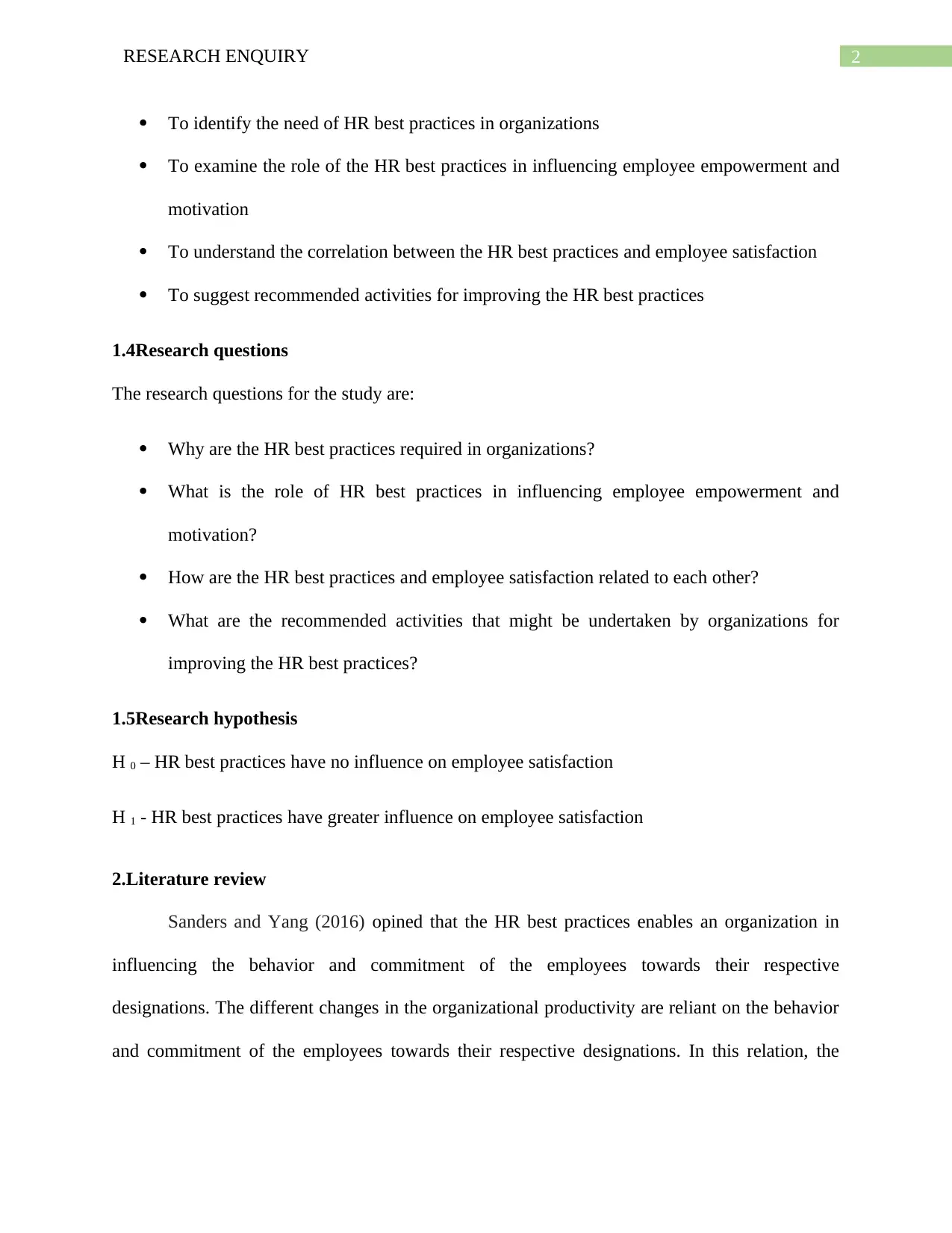
2RESEARCH ENQUIRY
To identify the need of HR best practices in organizations
To examine the role of the HR best practices in influencing employee empowerment and
motivation
To understand the correlation between the HR best practices and employee satisfaction
To suggest recommended activities for improving the HR best practices
1.4Research questions
The research questions for the study are:
Why are the HR best practices required in organizations?
What is the role of HR best practices in influencing employee empowerment and
motivation?
How are the HR best practices and employee satisfaction related to each other?
What are the recommended activities that might be undertaken by organizations for
improving the HR best practices?
1.5Research hypothesis
H 0 – HR best practices have no influence on employee satisfaction
H 1 - HR best practices have greater influence on employee satisfaction
2.Literature review
Sanders and Yang (2016) opined that the HR best practices enables an organization in
influencing the behavior and commitment of the employees towards their respective
designations. The different changes in the organizational productivity are reliant on the behavior
and commitment of the employees towards their respective designations. In this relation, the
To identify the need of HR best practices in organizations
To examine the role of the HR best practices in influencing employee empowerment and
motivation
To understand the correlation between the HR best practices and employee satisfaction
To suggest recommended activities for improving the HR best practices
1.4Research questions
The research questions for the study are:
Why are the HR best practices required in organizations?
What is the role of HR best practices in influencing employee empowerment and
motivation?
How are the HR best practices and employee satisfaction related to each other?
What are the recommended activities that might be undertaken by organizations for
improving the HR best practices?
1.5Research hypothesis
H 0 – HR best practices have no influence on employee satisfaction
H 1 - HR best practices have greater influence on employee satisfaction
2.Literature review
Sanders and Yang (2016) opined that the HR best practices enables an organization in
influencing the behavior and commitment of the employees towards their respective
designations. The different changes in the organizational productivity are reliant on the behavior
and commitment of the employees towards their respective designations. In this relation, the
⊘ This is a preview!⊘
Do you want full access?
Subscribe today to unlock all pages.

Trusted by 1+ million students worldwide
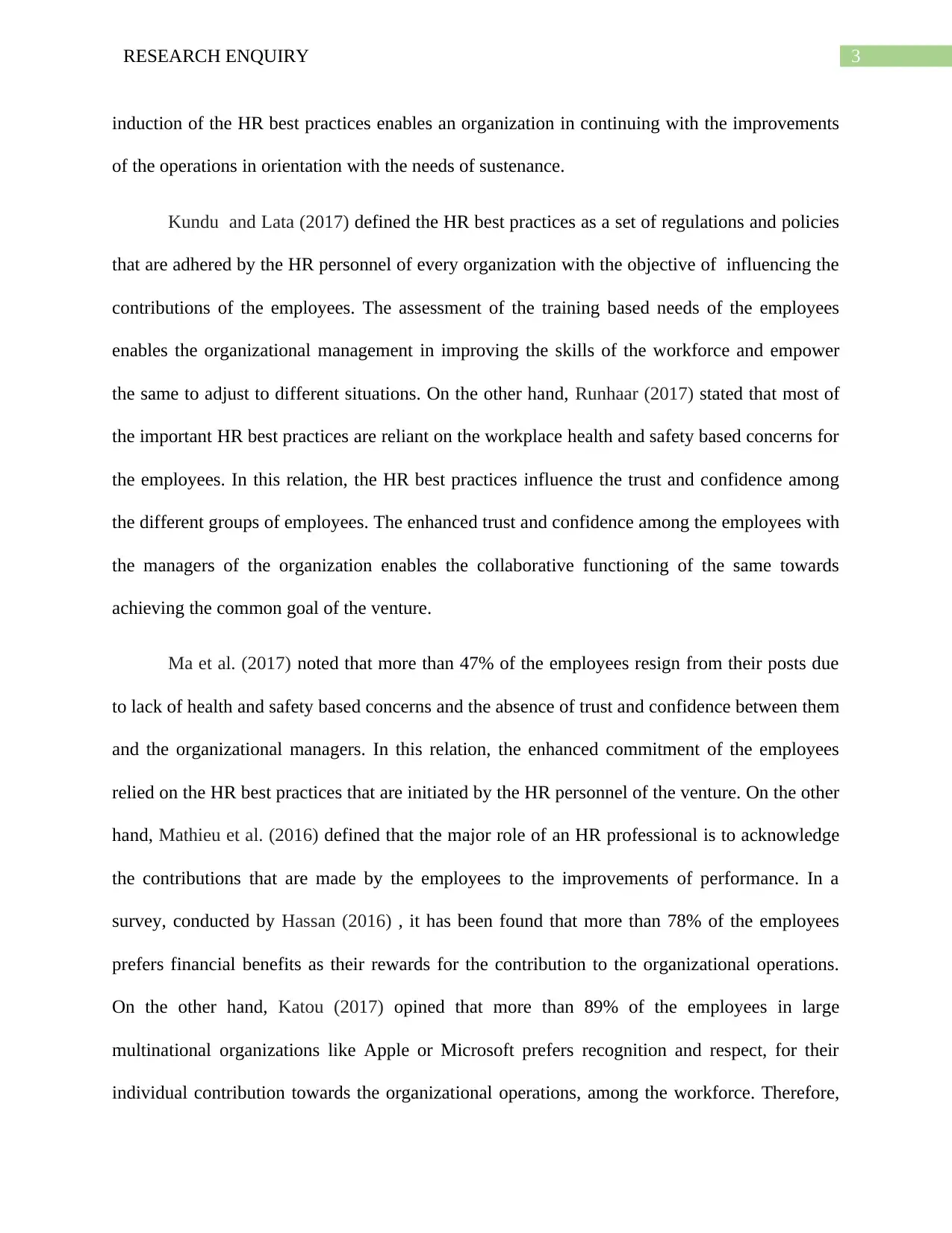
3RESEARCH ENQUIRY
induction of the HR best practices enables an organization in continuing with the improvements
of the operations in orientation with the needs of sustenance.
Kundu and Lata (2017) defined the HR best practices as a set of regulations and policies
that are adhered by the HR personnel of every organization with the objective of influencing the
contributions of the employees. The assessment of the training based needs of the employees
enables the organizational management in improving the skills of the workforce and empower
the same to adjust to different situations. On the other hand, Runhaar (2017) stated that most of
the important HR best practices are reliant on the workplace health and safety based concerns for
the employees. In this relation, the HR best practices influence the trust and confidence among
the different groups of employees. The enhanced trust and confidence among the employees with
the managers of the organization enables the collaborative functioning of the same towards
achieving the common goal of the venture.
Ma et al. (2017) noted that more than 47% of the employees resign from their posts due
to lack of health and safety based concerns and the absence of trust and confidence between them
and the organizational managers. In this relation, the enhanced commitment of the employees
relied on the HR best practices that are initiated by the HR personnel of the venture. On the other
hand, Mathieu et al. (2016) defined that the major role of an HR professional is to acknowledge
the contributions that are made by the employees to the improvements of performance. In a
survey, conducted by Hassan (2016) , it has been found that more than 78% of the employees
prefers financial benefits as their rewards for the contribution to the organizational operations.
On the other hand, Katou (2017) opined that more than 89% of the employees in large
multinational organizations like Apple or Microsoft prefers recognition and respect, for their
individual contribution towards the organizational operations, among the workforce. Therefore,
induction of the HR best practices enables an organization in continuing with the improvements
of the operations in orientation with the needs of sustenance.
Kundu and Lata (2017) defined the HR best practices as a set of regulations and policies
that are adhered by the HR personnel of every organization with the objective of influencing the
contributions of the employees. The assessment of the training based needs of the employees
enables the organizational management in improving the skills of the workforce and empower
the same to adjust to different situations. On the other hand, Runhaar (2017) stated that most of
the important HR best practices are reliant on the workplace health and safety based concerns for
the employees. In this relation, the HR best practices influence the trust and confidence among
the different groups of employees. The enhanced trust and confidence among the employees with
the managers of the organization enables the collaborative functioning of the same towards
achieving the common goal of the venture.
Ma et al. (2017) noted that more than 47% of the employees resign from their posts due
to lack of health and safety based concerns and the absence of trust and confidence between them
and the organizational managers. In this relation, the enhanced commitment of the employees
relied on the HR best practices that are initiated by the HR personnel of the venture. On the other
hand, Mathieu et al. (2016) defined that the major role of an HR professional is to acknowledge
the contributions that are made by the employees to the improvements of performance. In a
survey, conducted by Hassan (2016) , it has been found that more than 78% of the employees
prefers financial benefits as their rewards for the contribution to the organizational operations.
On the other hand, Katou (2017) opined that more than 89% of the employees in large
multinational organizations like Apple or Microsoft prefers recognition and respect, for their
individual contribution towards the organizational operations, among the workforce. Therefore,
Paraphrase This Document
Need a fresh take? Get an instant paraphrase of this document with our AI Paraphraser

4RESEARCH ENQUIRY
it might be stated that most of the employees hold the same expectation relating to rewards and
recognitions from their respective organizations.
The reward and recognition programs enables an organization in maintaining the
efficiency of the operations through induction of friendly competition among the employees. In
addition to the management related concerns, the HR best practices also enables an HR
professional in conducting 360 degree performance evaluation systems with the objective of
empowering the operations of the venture while operating in the different markets. The
evaluation of the performance of the workforce and the development of innovative procedures
for empowering the operations would enable the HR professionals in maximizing the
engagement of the employees in the different processes. Ogbonnaya et al. (2017) opined that the
performance evaluation enables an organization in maximizing the rate of operations while
operating in the different markets. Therefore, the HR personnel of an organization develops
efficient reporting and evaluation systems with the objective of influencing the operations of the
employees while operating in the different markets.
The key changes in the organizational operations are resultant of efficient communication
with the employees. In this relation, Bondarouk and Brewster (2016) stated that the HR
professionals improves the rate of communication between the managers and the workforce with
the objective of improving the collaborative functioning of the same. Steady links of
communication between the managers and the employees enables an organization in sharing
knowledge and identifying the issues and sources of conflict for mitigation. On the other hand,
the steady links of communication also enables an organization in maintaining the transparency
of the operations for retaining the trust and commitment of the employees towards the venture.
Therefore, the HR best practices that are undertaken by the organizations enables the same in
it might be stated that most of the employees hold the same expectation relating to rewards and
recognitions from their respective organizations.
The reward and recognition programs enables an organization in maintaining the
efficiency of the operations through induction of friendly competition among the employees. In
addition to the management related concerns, the HR best practices also enables an HR
professional in conducting 360 degree performance evaluation systems with the objective of
empowering the operations of the venture while operating in the different markets. The
evaluation of the performance of the workforce and the development of innovative procedures
for empowering the operations would enable the HR professionals in maximizing the
engagement of the employees in the different processes. Ogbonnaya et al. (2017) opined that the
performance evaluation enables an organization in maximizing the rate of operations while
operating in the different markets. Therefore, the HR personnel of an organization develops
efficient reporting and evaluation systems with the objective of influencing the operations of the
employees while operating in the different markets.
The key changes in the organizational operations are resultant of efficient communication
with the employees. In this relation, Bondarouk and Brewster (2016) stated that the HR
professionals improves the rate of communication between the managers and the workforce with
the objective of improving the collaborative functioning of the same. Steady links of
communication between the managers and the employees enables an organization in sharing
knowledge and identifying the issues and sources of conflict for mitigation. On the other hand,
the steady links of communication also enables an organization in maintaining the transparency
of the operations for retaining the trust and commitment of the employees towards the venture.
Therefore, the HR best practices that are undertaken by the organizations enables the same in

5RESEARCH ENQUIRY
enhancing the rate of satisfaction among the employees through taking care of a variety of
factors influencing the behavior and attitude of the employees towards the venture.
3.Methodology
3.1Research philosophy
The research will be initiated through the utilization of the positivism philosophy which
will enable in identifying the influence of the HR best practices on the rate of employee
satisfaction through assessment of natural phenomenon associated with the activities. Therefore,
the application of the positivism philosophy would support in examining the rationale of the
activities that are initiated by the HR personnel and would examine its impact on employee
contentment through exclusive sources of knowledge.
3.2Research approach
The research will be initiated through the application of deductive approach which will
focus on gathering data from the different sources of available information. The information that
would be gathered at the time of the research will be evaluated with the objective of identifying
the major impact of the HR best practices on the rate of employee satisfaction. The application of
the deductive approach will support in examining the past researches and models related to the
HR practices and their impact on employee commitment and satisfaction. Therefore, the
application of the deductive approach in the research will enable in enriching the study based on
assessing the influence of HR best practices on the employees.
3.3Research design
The research will be initiated through the utilization of explanatory research design
which will focus on identifying the correlation between the HR best practices and the employee
enhancing the rate of satisfaction among the employees through taking care of a variety of
factors influencing the behavior and attitude of the employees towards the venture.
3.Methodology
3.1Research philosophy
The research will be initiated through the utilization of the positivism philosophy which
will enable in identifying the influence of the HR best practices on the rate of employee
satisfaction through assessment of natural phenomenon associated with the activities. Therefore,
the application of the positivism philosophy would support in examining the rationale of the
activities that are initiated by the HR personnel and would examine its impact on employee
contentment through exclusive sources of knowledge.
3.2Research approach
The research will be initiated through the application of deductive approach which will
focus on gathering data from the different sources of available information. The information that
would be gathered at the time of the research will be evaluated with the objective of identifying
the major impact of the HR best practices on the rate of employee satisfaction. The application of
the deductive approach will support in examining the past researches and models related to the
HR practices and their impact on employee commitment and satisfaction. Therefore, the
application of the deductive approach in the research will enable in enriching the study based on
assessing the influence of HR best practices on the employees.
3.3Research design
The research will be initiated through the utilization of explanatory research design
which will focus on identifying the correlation between the HR best practices and the employee
⊘ This is a preview!⊘
Do you want full access?
Subscribe today to unlock all pages.

Trusted by 1+ million students worldwide
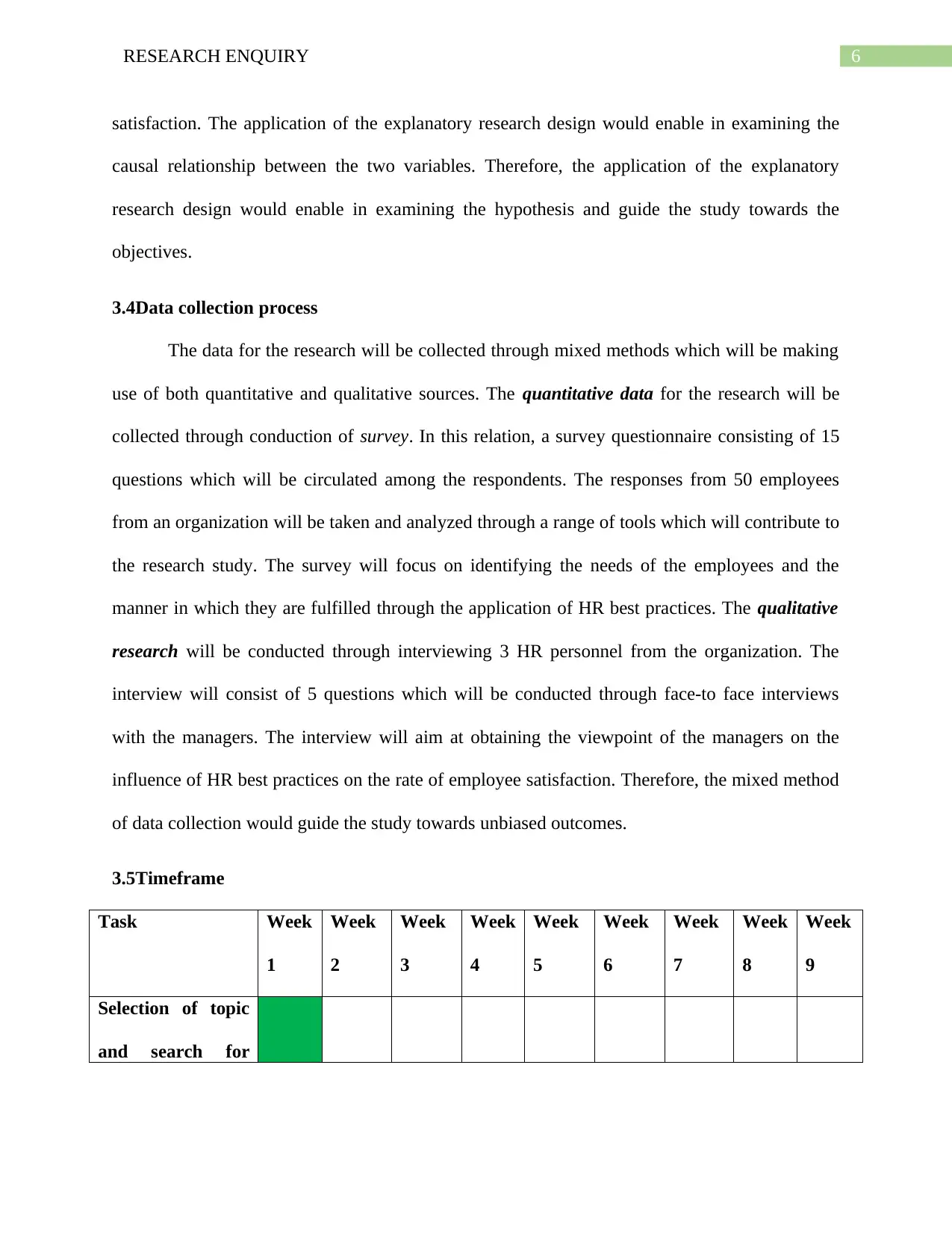
6RESEARCH ENQUIRY
satisfaction. The application of the explanatory research design would enable in examining the
causal relationship between the two variables. Therefore, the application of the explanatory
research design would enable in examining the hypothesis and guide the study towards the
objectives.
3.4Data collection process
The data for the research will be collected through mixed methods which will be making
use of both quantitative and qualitative sources. The quantitative data for the research will be
collected through conduction of survey. In this relation, a survey questionnaire consisting of 15
questions which will be circulated among the respondents. The responses from 50 employees
from an organization will be taken and analyzed through a range of tools which will contribute to
the research study. The survey will focus on identifying the needs of the employees and the
manner in which they are fulfilled through the application of HR best practices. The qualitative
research will be conducted through interviewing 3 HR personnel from the organization. The
interview will consist of 5 questions which will be conducted through face-to face interviews
with the managers. The interview will aim at obtaining the viewpoint of the managers on the
influence of HR best practices on the rate of employee satisfaction. Therefore, the mixed method
of data collection would guide the study towards unbiased outcomes.
3.5Timeframe
Task Week
1
Week
2
Week
3
Week
4
Week
5
Week
6
Week
7
Week
8
Week
9
Selection of topic
and search for
satisfaction. The application of the explanatory research design would enable in examining the
causal relationship between the two variables. Therefore, the application of the explanatory
research design would enable in examining the hypothesis and guide the study towards the
objectives.
3.4Data collection process
The data for the research will be collected through mixed methods which will be making
use of both quantitative and qualitative sources. The quantitative data for the research will be
collected through conduction of survey. In this relation, a survey questionnaire consisting of 15
questions which will be circulated among the respondents. The responses from 50 employees
from an organization will be taken and analyzed through a range of tools which will contribute to
the research study. The survey will focus on identifying the needs of the employees and the
manner in which they are fulfilled through the application of HR best practices. The qualitative
research will be conducted through interviewing 3 HR personnel from the organization. The
interview will consist of 5 questions which will be conducted through face-to face interviews
with the managers. The interview will aim at obtaining the viewpoint of the managers on the
influence of HR best practices on the rate of employee satisfaction. Therefore, the mixed method
of data collection would guide the study towards unbiased outcomes.
3.5Timeframe
Task Week
1
Week
2
Week
3
Week
4
Week
5
Week
6
Week
7
Week
8
Week
9
Selection of topic
and search for
Paraphrase This Document
Need a fresh take? Get an instant paraphrase of this document with our AI Paraphraser
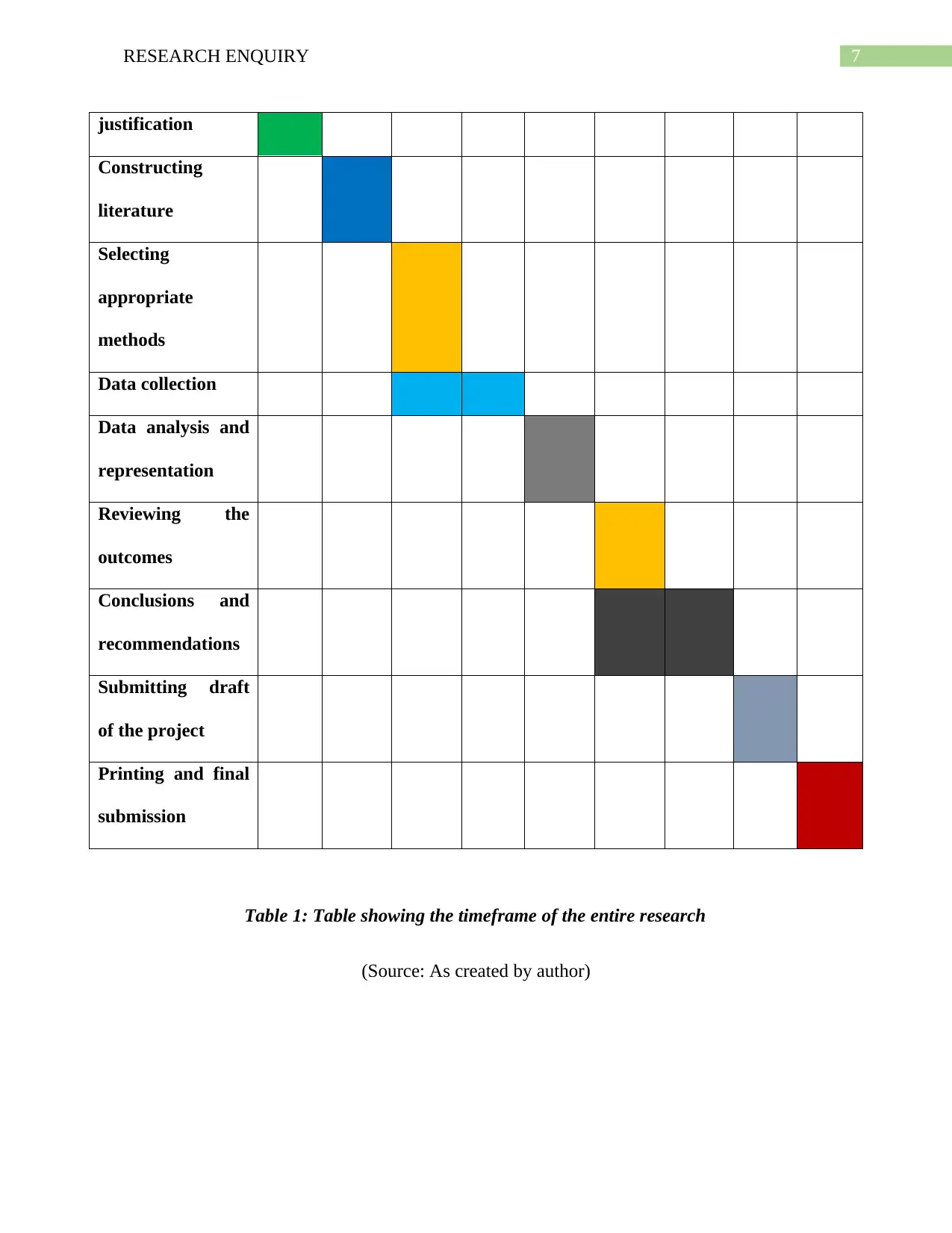
7RESEARCH ENQUIRY
justification
Constructing
literature
Selecting
appropriate
methods
Data collection
Data analysis and
representation
Reviewing the
outcomes
Conclusions and
recommendations
Submitting draft
of the project
Printing and final
submission
Table 1: Table showing the timeframe of the entire research
(Source: As created by author)
justification
Constructing
literature
Selecting
appropriate
methods
Data collection
Data analysis and
representation
Reviewing the
outcomes
Conclusions and
recommendations
Submitting draft
of the project
Printing and final
submission
Table 1: Table showing the timeframe of the entire research
(Source: As created by author)
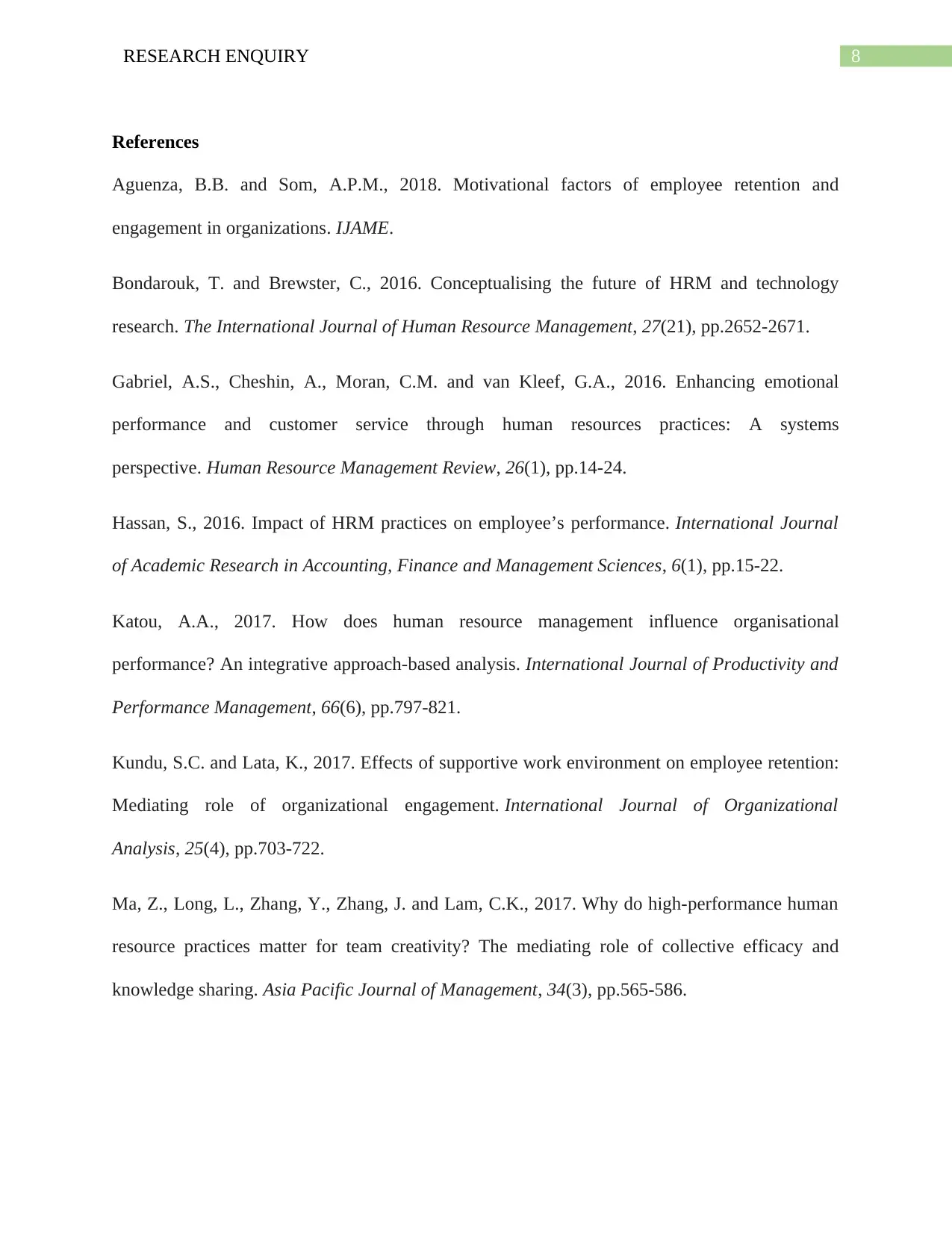
8RESEARCH ENQUIRY
References
Aguenza, B.B. and Som, A.P.M., 2018. Motivational factors of employee retention and
engagement in organizations. IJAME.
Bondarouk, T. and Brewster, C., 2016. Conceptualising the future of HRM and technology
research. The International Journal of Human Resource Management, 27(21), pp.2652-2671.
Gabriel, A.S., Cheshin, A., Moran, C.M. and van Kleef, G.A., 2016. Enhancing emotional
performance and customer service through human resources practices: A systems
perspective. Human Resource Management Review, 26(1), pp.14-24.
Hassan, S., 2016. Impact of HRM practices on employee’s performance. International Journal
of Academic Research in Accounting, Finance and Management Sciences, 6(1), pp.15-22.
Katou, A.A., 2017. How does human resource management influence organisational
performance? An integrative approach-based analysis. International Journal of Productivity and
Performance Management, 66(6), pp.797-821.
Kundu, S.C. and Lata, K., 2017. Effects of supportive work environment on employee retention:
Mediating role of organizational engagement. International Journal of Organizational
Analysis, 25(4), pp.703-722.
Ma, Z., Long, L., Zhang, Y., Zhang, J. and Lam, C.K., 2017. Why do high-performance human
resource practices matter for team creativity? The mediating role of collective efficacy and
knowledge sharing. Asia Pacific Journal of Management, 34(3), pp.565-586.
References
Aguenza, B.B. and Som, A.P.M., 2018. Motivational factors of employee retention and
engagement in organizations. IJAME.
Bondarouk, T. and Brewster, C., 2016. Conceptualising the future of HRM and technology
research. The International Journal of Human Resource Management, 27(21), pp.2652-2671.
Gabriel, A.S., Cheshin, A., Moran, C.M. and van Kleef, G.A., 2016. Enhancing emotional
performance and customer service through human resources practices: A systems
perspective. Human Resource Management Review, 26(1), pp.14-24.
Hassan, S., 2016. Impact of HRM practices on employee’s performance. International Journal
of Academic Research in Accounting, Finance and Management Sciences, 6(1), pp.15-22.
Katou, A.A., 2017. How does human resource management influence organisational
performance? An integrative approach-based analysis. International Journal of Productivity and
Performance Management, 66(6), pp.797-821.
Kundu, S.C. and Lata, K., 2017. Effects of supportive work environment on employee retention:
Mediating role of organizational engagement. International Journal of Organizational
Analysis, 25(4), pp.703-722.
Ma, Z., Long, L., Zhang, Y., Zhang, J. and Lam, C.K., 2017. Why do high-performance human
resource practices matter for team creativity? The mediating role of collective efficacy and
knowledge sharing. Asia Pacific Journal of Management, 34(3), pp.565-586.
⊘ This is a preview!⊘
Do you want full access?
Subscribe today to unlock all pages.

Trusted by 1+ million students worldwide
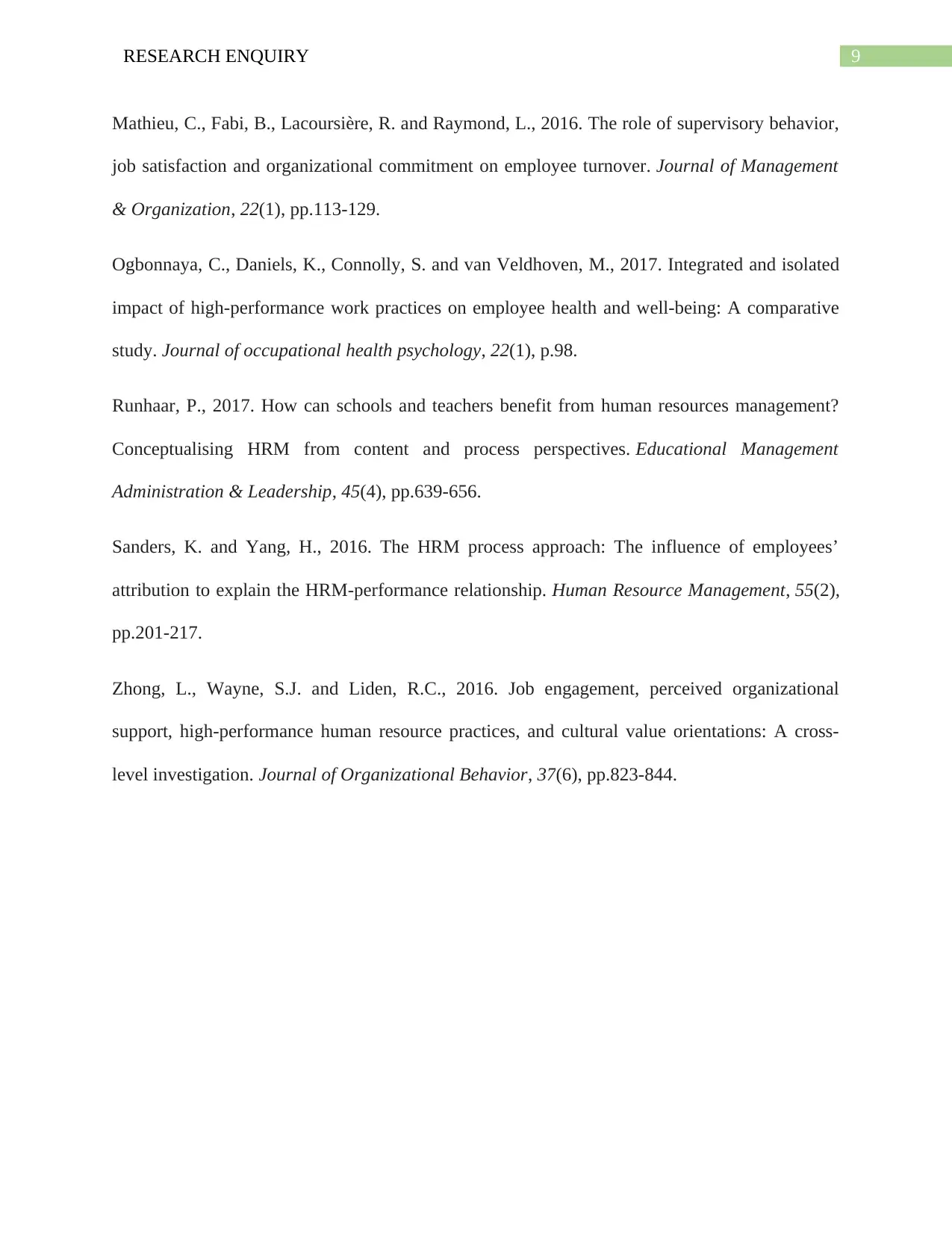
9RESEARCH ENQUIRY
Mathieu, C., Fabi, B., Lacoursière, R. and Raymond, L., 2016. The role of supervisory behavior,
job satisfaction and organizational commitment on employee turnover. Journal of Management
& Organization, 22(1), pp.113-129.
Ogbonnaya, C., Daniels, K., Connolly, S. and van Veldhoven, M., 2017. Integrated and isolated
impact of high-performance work practices on employee health and well-being: A comparative
study. Journal of occupational health psychology, 22(1), p.98.
Runhaar, P., 2017. How can schools and teachers benefit from human resources management?
Conceptualising HRM from content and process perspectives. Educational Management
Administration & Leadership, 45(4), pp.639-656.
Sanders, K. and Yang, H., 2016. The HRM process approach: The influence of employees’
attribution to explain the HRM‐performance relationship. Human Resource Management, 55(2),
pp.201-217.
Zhong, L., Wayne, S.J. and Liden, R.C., 2016. Job engagement, perceived organizational
support, high‐performance human resource practices, and cultural value orientations: A cross‐
level investigation. Journal of Organizational Behavior, 37(6), pp.823-844.
Mathieu, C., Fabi, B., Lacoursière, R. and Raymond, L., 2016. The role of supervisory behavior,
job satisfaction and organizational commitment on employee turnover. Journal of Management
& Organization, 22(1), pp.113-129.
Ogbonnaya, C., Daniels, K., Connolly, S. and van Veldhoven, M., 2017. Integrated and isolated
impact of high-performance work practices on employee health and well-being: A comparative
study. Journal of occupational health psychology, 22(1), p.98.
Runhaar, P., 2017. How can schools and teachers benefit from human resources management?
Conceptualising HRM from content and process perspectives. Educational Management
Administration & Leadership, 45(4), pp.639-656.
Sanders, K. and Yang, H., 2016. The HRM process approach: The influence of employees’
attribution to explain the HRM‐performance relationship. Human Resource Management, 55(2),
pp.201-217.
Zhong, L., Wayne, S.J. and Liden, R.C., 2016. Job engagement, perceived organizational
support, high‐performance human resource practices, and cultural value orientations: A cross‐
level investigation. Journal of Organizational Behavior, 37(6), pp.823-844.
1 out of 10
Related Documents
Your All-in-One AI-Powered Toolkit for Academic Success.
+13062052269
info@desklib.com
Available 24*7 on WhatsApp / Email
![[object Object]](/_next/static/media/star-bottom.7253800d.svg)
Unlock your academic potential
Copyright © 2020–2025 A2Z Services. All Rights Reserved. Developed and managed by ZUCOL.





